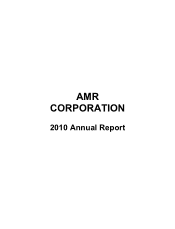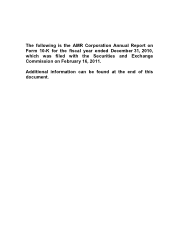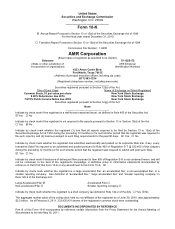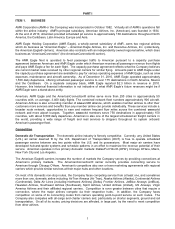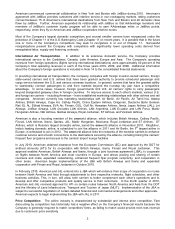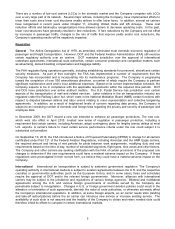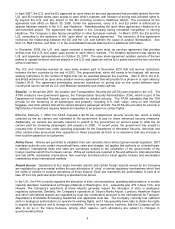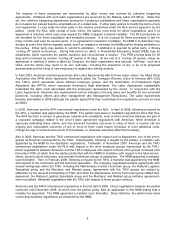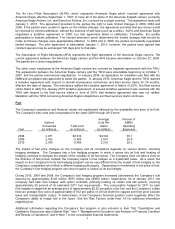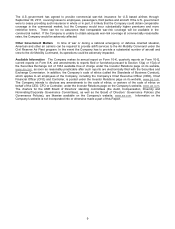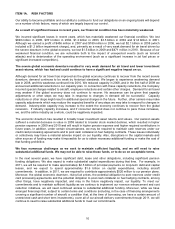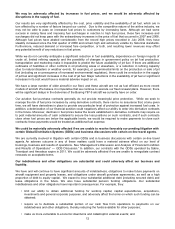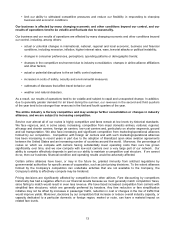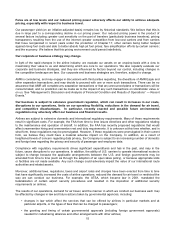American Airlines 2010 Annual Report Download - page 8
Download and view the complete annual report
Please find page 8 of the 2010 American Airlines annual report below. You can navigate through the pages in the report by either clicking on the pages listed below, or by using the keyword search tool below to find specific information within the annual report.
5
In 2006, the Wright Amendment Reform Act of 2006 (the Act) became law. The Act is based on an agreement by
the cities of Dallas and Fort Worth, Texas, DFW International Airport, Southwest, and the Company to modify the
Wright Amendment, which authorizes certain flight operations at Dallas Love Field within defined geographic
areas. Among other things, the Act eventually eliminates domestic geographic restrictions on operations while
limiting the maximum number of gates at Love Field. The Company believes the Act is a pragmatic resolution of
the issues related to the Wright Amendment and the use of Love Field.
Environmental Matters The Company is subject to various laws and government regulations concerning
environmental matters and employee safety and health in the U.S. and other countries. U.S. federal laws that
have a particular impact on the Company include the Airport Noise and Capacity Act of 1990 (ANCA), the Clean
Air Act, the Resource Conservation and Recovery Act, the Clean Water Act, the Safe Drinking Water Act, and the
Comprehensive Environmental Response, Compensation and Liability Act (CERCLA or the Superfund
Act). Certain operations of the Company concerning employee safety and health matters are also subject to the
oversight of the Occupational Safety and Health Administration (OSHA). The U.S. Environmental Protection
Agency (EPA), OSHA, and other federal agencies have been authorized to promulgate regulations that have an
impact on the Company's operations. In addition to these federal activities, various states have been delegated
certain authorities under the aforementioned federal statutes. Many state and local governments have adopted
environmental and employee safety and health laws and regulations, some of which are similar to or stricter than
federal requirements.
The ANCA recognizes the rights of airport operators with noise problems to implement local noise abatement
programs so long as they do not interfere unreasonably with interstate or foreign commerce or the national air
transportation system. Authorities in several cities have promulgated aircraft noise reduction programs, including
the imposition of nighttime curfews. The ANCA generally requires FAA approval of local noise restrictions on
aircraft. While the Company has had sufficient scheduling flexibility to accommodate local noise restrictions
imposed to date, the Company’s operations could be adversely affected if locally-imposed regulations become
more restrictive or widespread.
Many aspects of the Company’s operations are subject to increasingly stringent environmental regulations.
Concerns about climate change and greenhouse gas emissions, in particular, may result in the imposition of
additional legislation or regulation. For example, the EU recently approved measures that impose emissions limits
on airlines with operations to, from or within the EU as part of an emissions trading system beginning in 2012.
The Company is continuing to assess the potential costs of the EU measures. Such legislative or regulatory
action by the U.S., state or foreign governments currently or in the future may adversely affect the Company’s
business and financial results. See Item 1A, Risk Factors, for additional information.
The environmental laws to which the Company is subject include those related to responsibility for potential soil
and groundwater contamination. The Company is conducting investigation and remediation activities to address
soil and groundwater conditions at several sites, including airports and maintenance bases. The Company
anticipates that the ongoing costs of such activities will be immaterial. The Company has also been named as a
potentially responsible party (PRP) at certain Superfund sites. The Company’s alleged volumetric contributions at
such sites are small in comparison to total contributions of all PRPs and the Company expects that any future
payments of its share of costs at such sites will be immaterial.
Labor
The airline business is labor intensive. Wages, salaries and benefits represented approximately 31 percent of the
Company’s consolidated operating expenses for the year ended December 31, 2010. The average full-time
equivalent number of employees of the Company’s subsidiaries for the year ended December 31, 2010 was
78,250.

